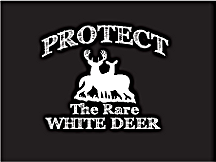
Why Save the White Deer?
 The practical reasons
The practical reasons
- White deer are a rare and beautiful natural resource (1 in 20,000) that many people enjoy seeing and watching.
- They are a unique part of the Leland community and add to its identity.
- Even though many landowners are protecting the white deer, the deer may move to places where they are not safe.
- Extensive news coverage has advertised the presence of the white deer in Leland and the fact that it is legal to shoot them.
- Because of their uniqueness and striking color, white deer are very attractive as trophies to some hunters.
- Because white deer are protected in the rest of Wisconsin, it makes them more vulnerable as a legal target in the Leland area.
- Because some stores will pay money for unusual mounts, hunters may have an added incentive to shoot a white deer.
- Whether white deer are inferior to brown deer may not be the case. The Leland herd appears healthy and thriving.
- Arguments that white deer are more vulnerable to predators are unsubstantiated. They are more easily seen by humans.
- Management goals for reducing herd size in CWD zones can be accomplished without killing a dozen white deer that are special to the Leland community.
- Wisconsin has protected white and albino deer since 1940–almost 73 years.
- Other states consider white deer special enough to protect.
- A lot of people besides Leland area residents think the white deer are worth saving.
The moral reasons
“If I kill this deer, I deny another the same experience.”
From a reader post on an Outdoor Life website, a hunter talks about killing a white deer (edited for structure only).
“from charlie elk
Once upon a time I was an opportunist hunter. If I came across fowl or beast during an open season, I did my best to kill it. Then somewhere along the way it came to me I do not have to kill everything. Perhaps it was during my first white deer encounter, but I can’t be sure. While watching the particular small white doe, her pink eye shining back at me, a feeling of peace and contentment descended around me. With the thought; if I kill this deer, I deny another the same experience.
Like many hunters I have numerous mounts which I have always viewed as my feeble attempt at possession of their beauty and wildness, as all hunters come to realize eventually. The mount will trigger pleasant memories of the hunt (making it well worth the effort to get a mount).
But there is a certain sadness in the back reaches of your mind – your possession is never really complete.
Later,
Charlie”
An Argument For Preservation
Below is a letter that was sent to several local newspaper editors, columnists, and outdoor writers prior to the April 14, 2014 Wisconsin Conservation Congress vote on a proposal (#35) to make the hunting of white deer legal in the state. The outdoor congress is predominantly attended by hunters and is only advisory to the DNR Board, but reflects hunter attitudes. The resolution ultimately lost by a 2 to 1 majority, which will hopefully send a message to lawmakers that even among hunters, shooting white deer is not a popular idea.

